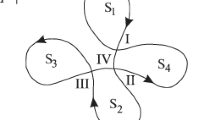Abstract
It was concluded that cytochrome oxidase was a strange enzyme for three reasons. (1) The thermodynamic flux-force relationship of this enzyme was inverse in some conditions: flux decreased when force increased. (2) The flux-force relationship was not unique and depended on the way in which the thermodynamic span of cytochrome oxidase was changed. (3) The regulation of cytochrome oxidase was different in the same conditions when different external parameters (energy demand, oxygen concentration) were changed.
It was also shown that the flux control coefficient of cytochrome oxidase, small at saturating oxygen concentration, increases when oxygen pressure diminishes, approaching unity at very low oxygen concentrations. (Mol Cell Biochem 174: 137–141, 1997)
Similar content being viewed by others
References
Rottenberg H: The thermodynamic description of enzyme-catalyzed reactions. Biophys J 13: 503–511, 1973
Rottenberg H: Non-equilibrium thermodynamics of energy conversion in bioenergetics. Biochim Biophys Acta 549: 225–253, 1979
Westerhoff HV, van Dam K: Thermodynamics and control of free-energy transduction, Elsevier, Amsterdam, 1987
Wilson DF, Erecińska M, Drown C, Silver IA: The oxygen dependence of cellular energy metabolism. Arch Biochem Biophys 195: 485–493, 1979
Kashiwagura T, Wilson DF, Ereciäska M: Oxygen dependence of cellular metabolism: the effect of O2 tension on gluconeogenesis and urea synthesis in isolated rat hepatocytes. J Cell Physiol 120: 13–18, 1984
Rodich F, Kadenbach B: Tissue specific regulation of cytochrome c oxidase efficiency by nucleotides. Biochemistry 32: 8499–8503, 1993
Gnaiger E, Steinlechner-Maran R, Mendez G, Eberl T, Margreiter R: Control of mitochondrial and cellular respiration by oxygen. J Bioenerg Biomembr 27: 583–596, 1995
Korzeniewski B, Froncisz W: Thermodynamic response paradigm and its application to oxidative phosphorylation. In: S Schuster, M Rigoulet, R Ouabi, J-P Mazat (eds). Modern Trends in BioThermoKinetics. Plenum Press, New York, 1993, pp 33–38
Korzeniewski B, Froncisz W: An extended dynamic model of oxidative phosphorylation. Biochim Biophys Acta 1060: 210–223, 1991
Korzeniewski B, Froncisz W: Theoretical studies on the control of the oxidative phosphorylation system. Biochim Biophys Acta 1102: 67–75, 1992
Korzeniewski B: Simulation of state 4-state 3 transition. Biophysical Chemistry 57: 143–153, 1996
Korzeniewski B, Mazat J-P: Theoretical studies on the control of oxidative phosphorylation in muscle mitochondria: application to mitochondrial deficiencies. Biochem J 319: 143–148, 1996
Korzeniewski B, Mazat J-P: Theoretical studies on control of oxidative phosphorylation in muscle mitochondria at different energy demands and and oxygen concentrations. Acta Biotheoretica 44: 263–269, 1996
Author information
Authors and Affiliations
Rights and permissions
About this article
Cite this article
Korzeniewski, B. Thermodynamic regulation of cytochrome oxidase. Mol Cell Biochem 174, 137–141 (1997). https://doi.org/10.1023/A:1006823500429
Issue Date:
DOI: https://doi.org/10.1023/A:1006823500429




